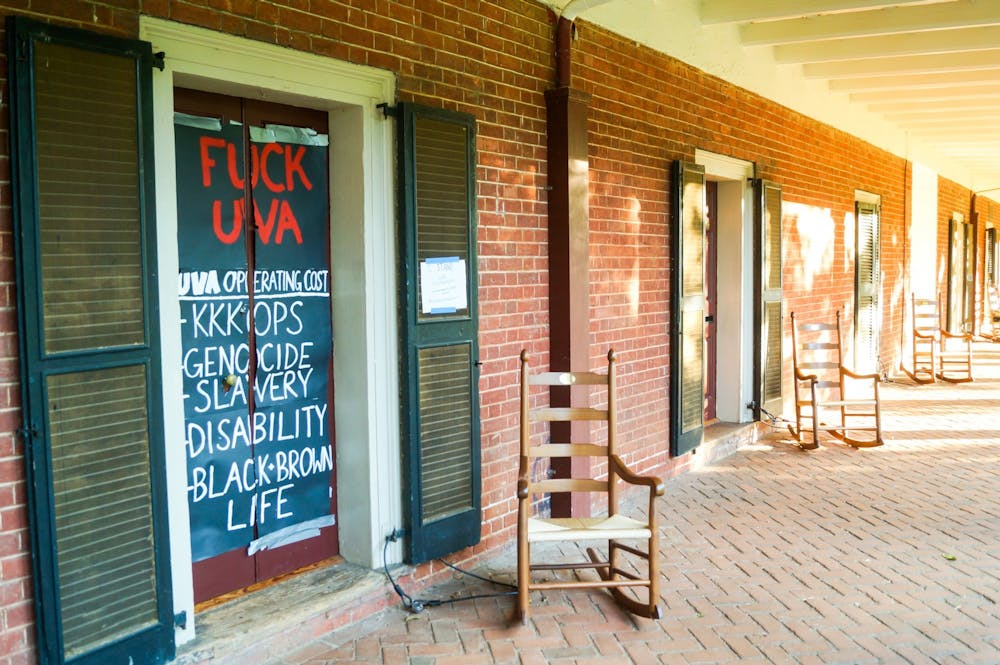Lea en español
Last semester, a sign saying “F—k UVA”, among other things, appeared on the door of a Lawn room, igniting a wave of controversy. Now, the same Lawn resident has once again spurred debate on Grounds following her display of another sign which notably featured the Rotunda engulfed in flames and draped in a Klansmen’s hood followed by a Kwame Ture quote. While the University administration defended the student’s right to post such material in the fall, the spring semester has witnessed a disappointing departure from this earlier stance. Even before the student posted her most recent sign March 12, Housing and Residence Life unveiled a new set of regulations on Lawn room postings that will take effect the next academic year. This was followed by the University physically removing the questionable sign the same day it was posted under the pretense that it “directly promot[ed] physical violence.” Both these actions are insulting to the University community and reveal that the administration has all but a shallow commitment to upholding the First Amendment rights of students.
Let me be clear — while I am sympathetic to the issues of racial injustice and police reform that the student intended to raise, I find the sign itself needlessly incendiary and misguided in its targets. Yet as Voltaire famously said, “I disapprove of what you say, but I’ll defend to the death your right to say it.” Thus, I am not particularly concerned with the response to this specific sign, but I am more outraged by the general principle of restricting the avenues that students at the University have to express themselves through.
First, with respect to HRL’s new restrictions, the policy appears to simply inconvenience students while simultaneously failing to accomplish the ostensible objective of reducing controversial materials on the Lawn. The new policy would require Lawn residents to confine their messages and materials to a 1.5-by-2 ft. board affixed to the doors of individual Lawn rooms. The rationale behind this requirement is confusing, as it is unlikely that the original content or subject material will change substantially just because the surface area available to post these messages is reduced. All that is likely to result from this is an increase in demand for 1.5-by-2 ft. sheets of paper. This is still a large area and thus future controversial posters will be prominently visible on the Lawn — just as they were before the policy was enacted.
The above is not to say that the University should aim to police content. In fact, doing so would be antithetical to a public institution that prides itself on its historical connection to the founders of American democracy. Yet, this appears to be exactly what occurred March 12 when facilities removed the aforementioned poster featuring the Rotunda engulfed in flames. The reported reason for the removal of the sign was that it had the “potential for incitement”. However, this is rather unconvincing seeing as — while containing provocative imagery — the poster did not specify a particular audience, lacked a call for a specific action and devoted the majority of its text to a quote from a public figure. The prospect of this sign directly inciting violence appears so remote that the administration’s reasoning must be contrived, as there is likely no cognizable scenario where the sign satisfies the “imminent lawless action” test established in Brandenburg v. Ohio. The community’s interest in ensuring that all students’ voices and perspectives are heard far outweighs the harm resulting from any violence that may ensue. In this instance, it strongly appears that the University inappropriately expanded the definition of incitement to censor content that may make some uncomfortable.
If this is true, the University’s actions are deeply alarming. At its heart, the University should be a place that encourages the free exchange of ideas — a place where reason and error are free to collide and everyone is made better off by it. The response to objectionable speech or materials should be more debate, not less. The prospect that a subset of the population may be offended by the self-expression of others does not provide proper justification for the administration to stifle one’s speech. Our constitutional rights are not derivative of the sensitivities of others.
For the majority of my time at the University, I have taken pride in the resolve the administration has shown for defending the rights of students. When I was a first year at orientation, I was encouraged by Dean Groves’ presentation on the First Amendment. Furthermore, I am proud to go to one of the few universities with a green light rating from the Foundation for Individual Rights in Education, and I am grateful that the University allows discontented student staffers in HRL to speak openly to the media. However, the fact that we have previously enjoyed such expansive freedoms requires us to be hyper-vigilant to ensure that the administration does not take actions — as they have done recently — that threaten to erode the rights of students.
Max Bresticker is an Opinion Columnist for The Cavalier Daily. He can be reached at opinion@cavalierdaily.com.
The opinions expressed in this column are not necessarily those of The Cavalier Daily. Columns represent the views of the authors alone.







